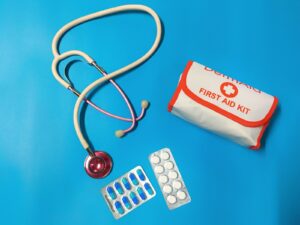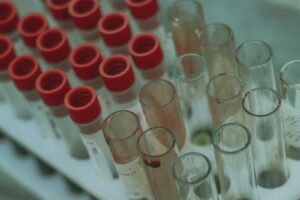 Welcome to a comprehensive exploration of the lifesaving world of drugs used in combating cyanide poisoning. If you’re diving into this topic for the first time or looking to deepen your knowledge, you’ve landed in the right place. This article unpacks the key treatments and medical strategies that stand between us and the potentially lethal effects of cyanide exposure. From the science behind cyanide’s danger to the body to the frontline drugs that offer a beacon of hope, get ready to learn about the critical answers to cyanide poisoning drug therapies and more.
Welcome to a comprehensive exploration of the lifesaving world of drugs used in combating cyanide poisoning. If you’re diving into this topic for the first time or looking to deepen your knowledge, you’ve landed in the right place. This article unpacks the key treatments and medical strategies that stand between us and the potentially lethal effects of cyanide exposure. From the science behind cyanide’s danger to the body to the frontline drugs that offer a beacon of hope, get ready to learn about the critical answers to cyanide poisoning drug therapies and more.
The Hidden Danger of Cyanide Poisoning: Understanding the Risk
 Cyanide, a highly toxic chemical found in certain industrial processes and smoke from fires, poses a significant risk to human health. Exposure to cyanide can disrupt the body’s ability to use oxygen, leading to rapidly developing symptoms and, without prompt treatment, can be fatal. Recognizing the danger is the first step toward prevention and effective response. Sources of exposure might include industrial accidents, residential fires, certain plant seeds, and even some chemical reactions. Awareness of these risks allows individuals and organizations to implement safety measures and prepare for potential emergencies.
Cyanide, a highly toxic chemical found in certain industrial processes and smoke from fires, poses a significant risk to human health. Exposure to cyanide can disrupt the body’s ability to use oxygen, leading to rapidly developing symptoms and, without prompt treatment, can be fatal. Recognizing the danger is the first step toward prevention and effective response. Sources of exposure might include industrial accidents, residential fires, certain plant seeds, and even some chemical reactions. Awareness of these risks allows individuals and organizations to implement safety measures and prepare for potential emergencies.
Understanding cyanide poisoning is crucial; it empowers you to recognize symptoms such as rapid breathing, dizziness, and weakness, which necessitate immediate medical attention. This knowledge isn’t just vital—it could save lives.
First Responders in Cyanide Crisis: An Overview of Antidotes
When facing cyanide poisoning, the prompt use of specific antidotes can mean the difference between life and death. Drugs used in cyanide poisoning work by neutralizing the toxin or aiding the body in converting it to less harmful substances. The most recognized treatments include hydroxocobalamin and sodium thiosulfate, each playing a pivotal role in detoxification processes. These antidotes act rapidly to bind with cyanide ions, transforming them into less toxic compounds that can be safely excreted from the body. Swift administration is critical, often requiring emergency medical teams to carry these life-saving drugs. Understanding the availability and action of these antidotes is key for anyone involved in high-risk industries or emergency response, emphasizing the importance of preparedness in the face of potential cyanide exposure.
Navigating Treatment Options: Hydroxocobalamin and Cyanide Exposure
 Hydroxocobalamin stands as a frontline defense in the battle against cyanide poisoning. When introduced into the body, it binds with cyanide molecules, forming a non-toxic complex that is easily eliminated. This attribute makes hydroxocobalamin a preferred choice among healthcare professionals, especially in scenarios of acute cyanide exposure. Its administration requires medical oversight and is typically done intravenously, ensuring rapid assimilation and effectiveness. The drug’s capacity to act quickly and efficiently makes it an invaluable tool in emergency medicine, particularly in cases of mass exposure or industrial accidents. As treatment protocols evolve, hydroxocobalamin’s role in cyanide detoxification highlights the advances in medical science’s approach to managing and mitigating the effects of toxic substances on human health.
Hydroxocobalamin stands as a frontline defense in the battle against cyanide poisoning. When introduced into the body, it binds with cyanide molecules, forming a non-toxic complex that is easily eliminated. This attribute makes hydroxocobalamin a preferred choice among healthcare professionals, especially in scenarios of acute cyanide exposure. Its administration requires medical oversight and is typically done intravenously, ensuring rapid assimilation and effectiveness. The drug’s capacity to act quickly and efficiently makes it an invaluable tool in emergency medicine, particularly in cases of mass exposure or industrial accidents. As treatment protocols evolve, hydroxocobalamin’s role in cyanide detoxification highlights the advances in medical science’s approach to managing and mitigating the effects of toxic substances on human health.
Sodium Thiosulfate: The Unsung Hero in Cyanide Detoxification
Sodium thiosulfate serves as an unsung hero in the realm of cyanide detoxification, offering a secondary but no less crucial line of defense. It operates by providing sulfur, which the body uses to convert cyanide into thiocyanate, a far less harmful substance that is readily excreted. Often used in conjunction with other treatments like hydroxocobalamin, sodium thiosulfate enhances the overall efficacy of the antidotal therapy.
Its role is particularly significant in cases of prolonged or significant exposure where the body’s cyanide levels are alarmingly high. While its administration is typically via intravenous injection, the process is straightforward, allowing for prompt action in emergency scenarios. This compound’s ability to safely and efficiently neutralize cyanide underscores its value in life-saving medical protocols, showcasing the importance of chemical knowledge in medical treatments.
Amyl Nitrite and Sodium Nitrite: Oxygenating Blood Amidst Cyanide Toxicity
 Amyl nitrite and sodium nitrite stand as critical components in the fight against cyanide toxicity, primarily through their capacity to induce methemoglobinemia. This condition, while seemingly counterintuitive, works to the patient’s advantage in cases of cyanide poisoning. By converting hemoglobin into methemoglobin, these agents allow for the binding of cyanide, reducing its interference with the body’s cellular respiration. This process temporarily detains cyanide ions, preventing them from wreaking havoc on the body’s cells and buying valuable time for the administration of further antidotal treatments. Administered under careful supervision, these nitrites enhance the body’s resilience against cyanide’s lethal effects, underscoring the sophisticated dance between leveraging controlled reactions and mitigating risk in emergency medical care.
Amyl nitrite and sodium nitrite stand as critical components in the fight against cyanide toxicity, primarily through their capacity to induce methemoglobinemia. This condition, while seemingly counterintuitive, works to the patient’s advantage in cases of cyanide poisoning. By converting hemoglobin into methemoglobin, these agents allow for the binding of cyanide, reducing its interference with the body’s cellular respiration. This process temporarily detains cyanide ions, preventing them from wreaking havoc on the body’s cells and buying valuable time for the administration of further antidotal treatments. Administered under careful supervision, these nitrites enhance the body’s resilience against cyanide’s lethal effects, underscoring the sophisticated dance between leveraging controlled reactions and mitigating risk in emergency medical care.
Preventive Measures and Safety Protocols: Minimizing Cyanide Risk
Minimizing cyanide risk is pivotal in both industrial settings and daily life, necessitating robust preventive measures and safety protocols. Awareness and education play vital roles, ensuring that individuals understand potential sources of cyanide exposure, such as certain manufacturing processes, smoke from fires, and even some foods and plants. Implementing strict safety standards, like proper ventilation, personal protective equipment (PPE), and regular training, can significantly reduce the likelihood of accidental exposure. Additionally, having emergency plans in place, including the availability of antidotes such as hydroxocobalamin and sodium thiosulfate, ensures a swift response to potential poisoning incidents. Emphasizing prevention, preparedness, and knowledge not only protects health but also enhances the ability to act decisively and effectively in the event of cyanide exposure.